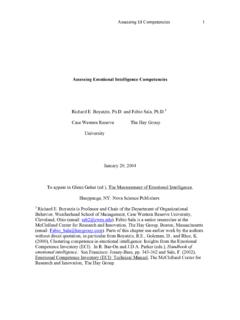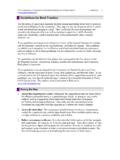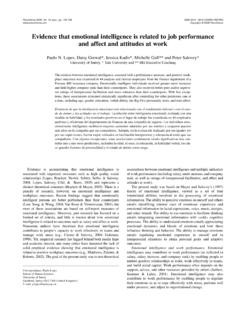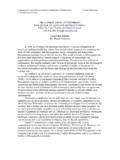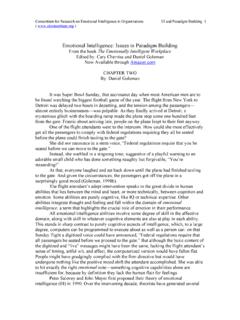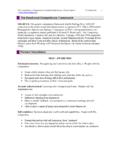Transcription of Group Emotional Intelligence (GEI) Survey
1 2006 GEI Partners Group Emotional Intelligence (GEI) Survey Technical Manual prepared by Steven B. Wolff March 5, 2006 781-330-0899 2006 GEI Partners i TABLE OF CONTENTS Background of Group Emotional Intelligence Theory .. 1 Summary of the theory .. 1 Individual-Level Norms .. 2 Group -Level 2 Cross-Boundary-Level Norms .. 3 Development of the Survey .. 3 Using the GEI Survey .. 3 Number of Team Members .. 4 How Norms Develop .. 4 Differences in perspectives .. 4 Reliability .. 5 Validity .. 6 GEI and Group Performance in MBA 6 GEI, Social Capital, and Group Performance in Fortune 500 7 Emotional Intelligence , Group Emotional Intelligence , and the Performance of Military Air 9 References .. 10 2006 GEI Partners 1 Background of Group Emotional Intelligence Theory The theory of Group Emotional Intelligence (GEI) was developed by Vanessa Urch Druskat and Steven B.
2 Wolff. The following references provide an in-depth discussion of the theory (Druskat & Wolff, 2001a, 2001b; Wolff, Druskat, Koman, & Messer, 2006). Summary of the theory Group Emotional Intelligence is based Daniel Goleman s (1995) framework of awareness and regulation of emotion at multiple levels but it should not be confused with individual Emotional Intelligence . The Intelligence in a Group comes from the patterns of behavior, or norms, that develop as the Group goes about its task. Group Emotional Intelligence is a Group -level construct and is very different from the individual-level Emotional Intelligence of Group members. Group Emotional Intelligence represents the ability of a Group to generate a set of norms that guide the Emotional experience in a Group in an effective way.
3 There are norms that guide the Group s interaction with: its members (individual-level), the Group as a whole ( Group -level), and others outside the Group (cross-boundary level). At each of these levels there are norms that create awareness of emotion in the Group and norms that regulate Group behavior. The nine norms that make up a Group s Emotional Intelligence are shown in Table 1. Table 1: Group Emotional Intelligence Norms 3 Levels 6 Dimensions 9 Norms Individual Group awareness of members Interpersonal understanding Group management of members Confronting members who break norms Caring Behavior Group Group self-awareness Team self-evaluation Group self-management Creating resources for working with emotion Creating an affirmative environment Proactive problem solving Cross-boundary (External) Group social awareness Organizational understanding Group management of external relationships Building external relationships It is important to note that each norm by itself is not necessarily focused on emotion.
4 Each norm, however, does guide behavior in the Group that has Emotional outcomes. For example, 2006 GEI Partners 2 the degree to which members in the Group make an effort to understand one another (Interpersonal Understanding) affects the Emotional ties that develop among members and among each member and his or her identification with the Group . Individual-Level Norms At the individual level, the norm of Interpersonal Understanding helps the Group become aware of its members needs, perspectives, and emotions. The norms of Confronting Members Who Break Norms and Caring Behavior help guide the Group s behavior toward its members. Interpersonal Understanding this norm represents the degree to which a Group attempts to understand the needs, perspectives, skills, and emotions of its members.
5 The strength of this norm relates to the degree to which members build bonds among themselves and the degree to which members identify with the Group . Confronting Members Who Break Norms this norm represents the degree to which a Group addresses member behavior that goes against agreed upon norms or is harmful to Group effectiveness. This norm requires skills of empathy, self-control, and persuasion to carry it out effectively. It must also be coupled with the norm of Caring Behavior. This norm contributes to a sense of efficacy in the Group . When Group members know that disruptive behavior will be confronted, they feel more confident in the Group to accomplish its task. Caring Behavior this norm represents the degree to which a Group treats its members with respect, supports them, seeks their perspective, and validates their efforts.
6 It does not imply that team members must like each other or socialize with each other. The strength of this norm affects the degree to which members build bonds and identify with the team. It also contributes to a sense of safety in the Group . Group -Level Norms At the Group level, the norm of Team Self-Evaluation helps the Group become aware of how well it is working and the general mood in the Group . The norms of Creating Resources for Working with Emotion, Creating an Affirmative Environment, and Proactive Problem Solving guide the Group s behavior in a way that helps them address challenges in a way that creates positive energy yet avoids distorting the reality of the situation. Team Self-Evaluation this norm represents the degree to which a Group is aware of how it is performing, its collective moods, and seeks information to help it evaluate how well it is working.
7 This norm has Emotional consequences in that it can create Emotional threats. The next three norms help determine how well the Group deals with the Emotional threats. One key to an effective Group is to have a good sense of reality and not shy away from it when it gets emotionally threatening. Creating Resources for Working with Emotion this norm represents the degree to which a Group provides resources for the Group to address emotions, , time and a language for talking about emotions. 2006 GEI Partners 3 Creating an Affirmative Environment this norm represents the degree to which a Group stays positive and optimistic in the face of challenges. This norm has Emotional consequences because the degree to which members of the Group remain optimistic will affect their sense of efficacy and will minimize the sense of threat caused by the challenge.
8 Proactive Problem Solving this norm represents the degree to which a Group anticipates problems and takes action to prevent them as well as taking responsibility and working hard to address challenges. This norm has Emotional consequences similar to that of Creating an Affirmative Environment. The greater the degree to which a Group takes control of solving its problems the greater will be its sense of efficacy and the less threatening challenges will feel to Group members. Cross-Boundary-Level Norms At the cross-boundary level the norm of Organizational Understanding helps the Group become aware of the needs and concerns of those outside the Group and understand how its work fits into the organization. The norm of Building External Relations guides the Group s behavior based on their understanding of the organization.
9 Organizational Understanding this norm represents the degree to which a Group seeks to understand the needs and concerns of those outside the Group as well as the impact of its work and how it contributes to the organization s goals. This norm has Emotional consequences related to the relationship of the Group to decision makers and other groups. To build ties with others outside the Group it is first necessary to understand them. Building External Relations this norm represents the degree to which a Group actively and strategically builds relationships with other people and groups who can affect their performance and provide resources. This norm has Emotional consequences in that it builds bonds with others outside the Group as well as evokes cooperation and attracts resources that help the team accomplish its goals.
10 This leads to a sense of efficacy. Development of the Survey Our initial work identified 13 norms (see Druskat et al., 2001a) that represented the set of behaviors observed in emotionally competent groups. The items in the current version of the Survey represent a process of continual refinement based on previous research. Based on Christina Hamme s (2003) work as well as early work of Druskat and Wolff, the number of norms was cut from 13 to 9. Also based on this work and feedback from participants, items were reworded to improve clarity and relevance of the items. Finally, some items were deleted based on a factor analysis if they did not load on the appropriate factor. Using the GEI Survey The GEI Survey has two primary uses: team development and research.


